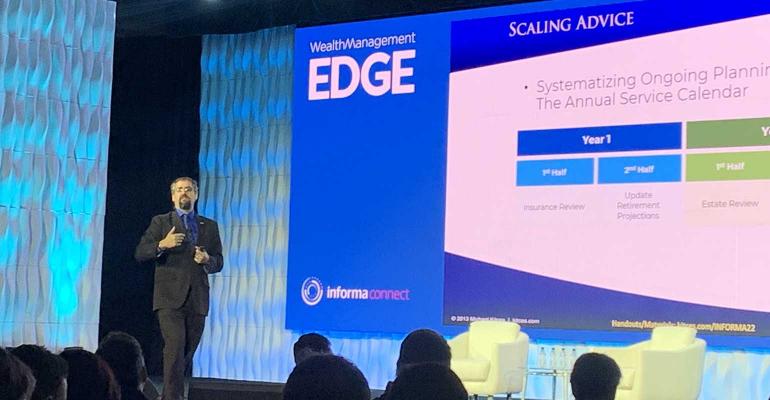Many financial technology companies promise to make advisors’ businesses more efficient and scale their advice models across their client bases, but the actual advice part of the business cannot be scaled, argued Michael Kitces, head of planning strategy at Buckingham Wealth Partners and chief financial planning nerd at Kitces.com. Technology can be used to scale the back-office aspects of an advisory business, but not the financial advice and planning portion, Kitces’ research shows. But there are steps advisors can take to scale their expertise.
“I’m all for technology, but the technology is not what drives it,” Kitces said, speaking at the Wealth Management EDGE conference at The Diplomat Beach Resort in Hollywood, Fla. “It’s wonderful for driving the back office, but what actually drives the efficiency in the client meetings themselves is much more around investing in our expertise, getting more systematized with our deliverables, reducing our own client variability that we impose on ourselves and putting other human beings behind us to support us for all middle-office tasks that can’t be supported by technology.”
One way advisors are making the ongoing process more efficient is by finding some common practices. A lot of advisors create an annual client service calendar, which describes all the advice stuff they will do for the client. That calendar lays out all the nonnecessary investments for the client.
Kitces gave an example of a two-year process for the service model, where in the first year, the advisor will review insurance policies and update retirement projections. In the second year, the advisor will review estate planning documents, update college projections, budgeting and cash flow.
“Here’s why it matters: When you do this as an annual service calendar that’s systematized, a couple of things start to change,” he said. “The first is, clients know it’s coming.”
This is a more proactive approach, he added, and helps avoid emergency situations that can be disruptive to the advisor.
“There’s this mad flurry of what goes on. It’s extremely disruptive for us," he said. "When this annual service calendar gets set, planning then becomes more proactive because we’ve created a structure for it, and suddenly a lot of disasters are not disasters.
“We still do the service; we still provide the value; we still provide the expertise. But we get more control over our time and our ability to serve clients because we’re not in constant reactionary mode by waiting for it to become an emergency for them and only then dealing with it when they call with an emergency.”
The added benefit is that when there’s a more systematized approach, the whole staff and team gets on board as well, he said.
Advisors can also get more efficient around how they deal with different types of clients and client variability.
One way to solve for that is having a specialized offering and taking something that clients want as an exception and going all in on it.
Advisory firms can also be more efficient by leveraging up their own time, and they can do that by hiring more support staff and associate advisors.
“We just expand our capacity not by dramatically reallocating how the time flows, but having less time per client because we’re leveraging our support team,” he said. “That’s where the efficiencies actually come from over time. It’s that lift from support staff.”
Kitces’ research shows advisors should hire their first administrative staff at around $250,000 in revenue or 40 clients. They typically hire an associate advisor at $400,000 in revenue or 75 clients.
Advisors will also see their income increase, as they add support staff. For instance, solo advisors make an average of $300,000 a year, Kitces said, but their income on the high end doubles after they hire support staff around them.
Regarding fee models, Kitces argued it’s not so much how advisors charge that creates value for clients but rather how they show up in meetings.
“In the simplest sense, it’s what on the agenda," he said. "A lot of advisory firms that charge an AUM fee, their whole agenda is it’s a portfolio performance review. Firms that focus on financial planning, it’s not.
“That’s how we start moving from this domain of sales people that sell products and services, generalist advisors who sell their time and what I call the advice service, who are actually in the advice business and sell expertise and wisdom.”





